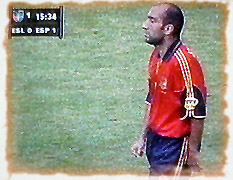in Latin America
Watching Soccer ![]() on
Television
on
Television
in Latin America
 Uruguay: Peñarol versus Nacional |
 Copa Europa: Spain versus Slovenia |
According to the Los Medios y Mercados de Latinoamérica 1998 study, 71% of Latin Americans between the ages of 12 and 64 years old watch soccer on television regularly. These games include intranational and international games, including championship games such as the World Cup, the Euro Cup, Copa Libertadores and Copa America, as well as matches from the Italian Serie A, the Liga Española, the English Premier League, the German Bundesliga and even the Japanese J-League. This makes soccer the most popular sport in terms of televised spectatorship. Why is this sport so popular? Janet Lever proposed that sport has the ability to divide and integrate simultaneously at multiple levels and therefore meets multiple needs.
In Latin America, professional soccer consists of national leagues at the top level. The teams in the national leagues are based in the different major cities of the country, thus creating regional rivalries. In countries where the distance between cities are too large, the soccer leagues may be run separately in states (such as the Carioca and Paulista leagues in Brazil) with national championships among the state champions. The best professional clubs are often typed demographically to represent specific groups, thus creating bitter, long-lasting rivalries. The best known club rivalries are:
Argentina: In Buenos Aires, Boca Juniors (working-class Italians) and River Plate (elitist English and Spanish)
Brazil: In Rio de Janeiro, Flamengo (working class) and Fluminense (elite)
Chile: In Santiago, Colo Colo (working-class) and Universidad (elite)
Peru: In Lima, Alianza Lima (mestizos) and Universitário (white Creole)
We will note in passing that even though these clubs are supposed to represent different segments of society, they have a common attribute --- they all have excellent websites! Club fans are united by their loyalties and divided from members of the same society who are fans of other clubs. Yet, quickly enough, a fan of one club will support a rival team from the same city when it comes to an inter-city championship. [Priscilla Ann Goslin in her funny How to be a Carioca book provided these instructions: "Every carioca has a favorite futebol team. If you are a real carioca, your team will be either Flamengo, Botafogo, or Fluminense, and depending which one you choose, you will be eternally referred to as a Flamenguista, Botaguense or Tricolor, meaning respectively a Flamengo, Botafogo or Fluminense fan. You will cherish your team second only to your mother and be more faithful to your team than to your own spouse. Consequently, once you have chosen your team you will despise the other two for as long as you live. If a team other than yours is playing a team from São Paulo, for example, in the finals of a national championship, you will simply ignore the entire event. Under all circumstances, a true Carioca will only acknowledge the existence of his own team."] And, of course, most certainly, all the club fans will unite to support the national team, composed of players from many different clubs.
Nations meet each other on soccer fields to contest each other. Soccer victories count for national pride. In the following table, we show the breakdown by country.
|
Country |
% watched soccer on television regularly |
| Argentina Bolivia Brazil Chile Colombia Costa Rica Dominican Republic Ecuador El Salvador Guatemala Honduras Mexico Nicaragua Panama Paraguay Peru Uruguay Venezuela |
72% 41% 85% 67% 70% 76% 27% 63% 76% 77% 74% 64% 12% 72% 52% 48% 51% 61% |
| TOTAL | 71% |
(Source: Los Medios y Mercados de Latinoamérica 1998)
We are not surprised to find Brazil leading the way. This particular survey was taken right after the 1998 World Cup, won by Brazil. Even without this extraordinary boost,, Brazil is known as 'soccer-mad.' In this list of countries, we find the Dominican Republic and (at 27%) and Nicaragua (at 12%) being significantly lower in soccer television viewership. The national sport in these two countries is baseball, not soccer. This points out the fact that while sport is almost universal as a social device for national integration, the choice of a specific sport may vary and be locked in through a path-dependent, irreversible manner.
In the next table, we show the demographic breakdown of the soccer television viewers.
| Demographic Characteristics | % watched soccer on television regularly |
| Sex Male Female |
82% 60% |
| Age 12 - 17 18 - 24 25 - 34 35 - 44 45 - 54 55 - 64 |
74% 73% 72% 70% 67% 64% |
| Years of education Less than 6 years Six years or more, but less than 12 years 12 years of more |
60% 75% 71% |
| Socio-economic
Level Level A (Top 10%) Level B (Next 20%) Level C (Next 30%) Level D (Bottom 40%) |
81% 76% 72% 65% |
| Major Urban Areas | 71% |
| Total | 71% |
(Source: Los Medios y Mercados de Latinoamérica 1998)
In the table above, the gender gap is the biggest one. This gap is for soccer television viewership only, and women may watch television just to have some conversation materials. The gender gap is much larger in participation in playing of soccer, as the game is believed to require masculine endurance and involves physical violence. According to Janet Lever (1995):
Sports transcends social divisions and brings diverse people together --- with one important exception: routinely sport separates women from men. Paul Hoch coined the term "sexual apartheid" to describe this near-universal phenomenon. Kate Millett likens sport to "men's house institutions" --- rituals that separate males from females and reinforce the values of male supremacy, aggression, competitiveness, and power. Anything that reduces the commonality of experience between the sexes reinforces strong gender distinctions and inhibits communication. (p.153).
|
|
|
|
Throughout the world, women's soccer is a relatively new sport. The first Women's World Cup was played in 1991. The most recent Women's World Cup was held in the USA in 1999, and was the first one that had extensive television coverage. Among the Latin American nations at that tournament, Mexico fielded a creditable team while Brazil proved conclusively that it belonged to in the top four nations with China, Norway and the USA. Furthermore, the Brazilian women played in the characteristically Brazilian style: dazzling footwork, quick dashes, imaginative passes, exciting set-plays and exuberant jouissance. In the more recent Concacaf Women's Gold Cup, the Brazilians barely lost to the USA after beating China. Considering the fact that the USA team was assembled to train for a long period of time with corporate sponsorship whereas the Brazilian team was assembled haphazardly from a bunch of club teams that are adjunct to men's professional teams, this was a phenomenal accomplishment. So, the question is, "Will international success bring about grass root participation?" rather than the normally expected "Will grassroots participation bring about international success?"
|
|
|
|
![]()
ZONA LATINA ARTICLES
WORLD WIDE WEB LINKS
SPORTS CABLE CHANNELS
BOOK REFERENCES
(posted by Roland Soong on 6/31/00)
(Return to Zona Latina's Home Page)